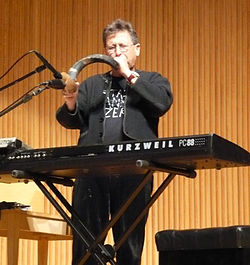This biography of a living person includes a list of references, related reading, or external links, but its sources remain unclear because it lacks inline citations .(December 2019) |

Alvin Curran (born December 13, 1938) is an American composer, performer, improviser, sound artist, and writer. He was born in Providence, Rhode Island, and lives and works in Rome, Italy. He is the co-founder, with Frederic Rzewski and Richard Teitelbaum, of Musica Elettronica Viva, and a former student of Elliott Carter. Curran's music often makes use of electronics and environmental found sounds. He was a professor of music at Mills College in California until 2006 and now teaches privately in Rome and sporadically at various institutions. [1] He is an artistic advisor at the American Academy in Rome. [2]
Contents
His works include solo performance pieces such as Endangered Species, TransDadaExpress, and Shofar; [3] radio works such as Crystal Psalms, Un Altro Ferragosto, I Dreamt John Cage Yodeling at the Zurich Hauptbahnhof, and Living Room Music; large-scale musical choreographic works such as Oh Brass on the Grass Alas, for 300 amateur brass-band musicians, and the Maritime Rites series of performances on and near water; sound installation works such as Magic Carpet, Floor Plan, The Twentieth Century, and Gardening with John; chamber music such as For Cornelius for piano, the trio Schtyx, the string quartet VSTO , the saxophone quartet Electric Rags II, the percussion quartet THEME PARK, a series of works for chorus SATB, and the work for chamber orchestra and video Circus Maximus; The Book of Beginnings for orchestra, youth orchestra, self-playing pianos, and cellphone app; and many collaborative dance and theater works. [4]
Since 1993, Curran has worked on Inner Cities , a growing series of solo piano pieces that together form one of the longest non-repetitive piano pieces ever written. Daniela Tortora has edited a book about his work, Alvin Curran Live in Roma (Die Schachtel 2010). In 2015 he published The Alvin Curran Fakebook, an atypical autobiography that includes photos, writings, and sketches alongside more than 200 scores and fragments ranging from raw sonic materials to conceptual musics and completed compositions. His articles have been published in the New York Times, Leonardo, The Contemporary Music Review, and Musiktexte, among others.
